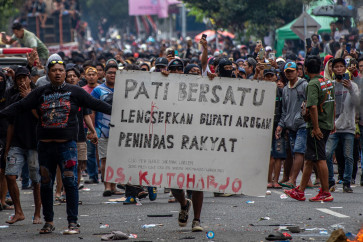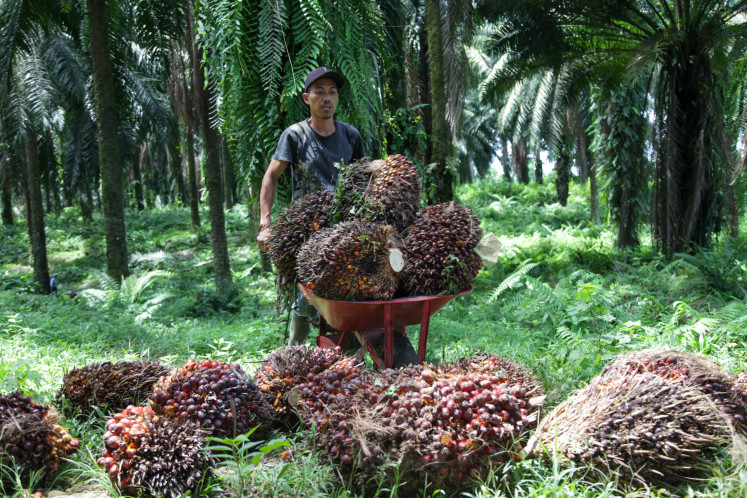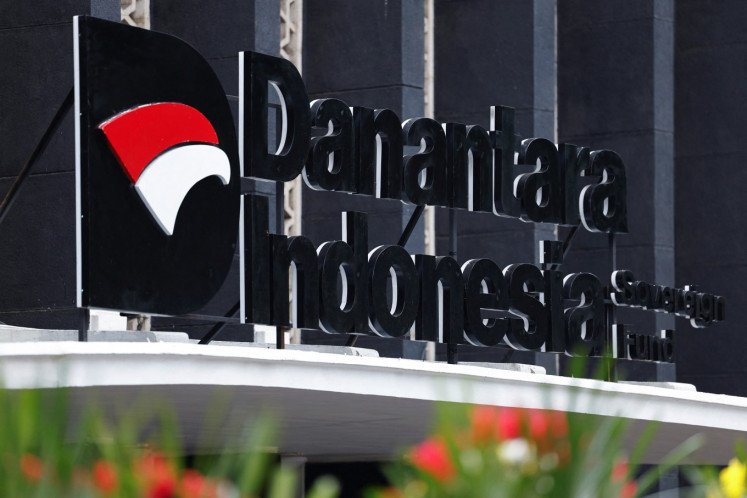Popular Reads
Top Results
Can't find what you're looking for?
View all search resultsPopular Reads
Top Results
Can't find what you're looking for?
View all search resultsWomen moving forward
Walk this way: Activists from women’s grassroots communities from 34 provinces across the country walk to the State Palace to meet with President Joko “Jokowi” Widodo on Wednesday
Change text size
Gift Premium Articles
to Anyone
W
alk this way: Activists from women’s grassroots communities from 34 provinces across the country walk to the State Palace to meet with President Joko “Jokowi” Widodo on Wednesday. The meeting, titled “Strengthening the Nation Together”, was held to commemorate International Women’s Day, which falls on March 8.(JP/Seto Wardhana)
More and more women are moving to the front lines of the nation’s development, taking up leadership roles in areas traditionally dominated by men such as engineering and peacekeeping.
The construction director and the head of railway engineering for the Jakarta MRT mega infrastructure project are both women, Silvia Halim and Tengku Alia Sanda.
Ahead of International Women’s Day on March 8, the two women, who have also contributed to maintaining peace in their communities, were recognized by UN Women for taking great strides in roles typically dominated by men.
Silvia Halim (jakartamrt.co.id)Silvia said she believed no jobs should be considered only for men and explained they were male-dominated simply because “they got a head start”.
“Remove the limits and whatever boxes we think there are. First, it comes from women themselves. Before they even start, they already limit themselves just because they are women,” said Silvia, who graduated from Nanyang Technological University (NTU).
“Nobody in my family was a civil engineer [...] I chose civil engineering because it was something that suited my personality. I’m the kind [of person] who likes to see the things I build,” Silvia said.
Silvia has worked for the Singapore Land Transport Authority for 12 years.
A report from UNESCO revealed that only 30.7 percent of researchers in the science, technology, engineering and mathematics (STEM) field in Indonesia are women. Meanwhile, a study published by the online research and news outlet Katadata in 2018 revealed that only two out of 10 women in Indonesia who graduated from STEM courses at university pursued professional careers in the field.
Strategic director of the student-led organization Fifty50 Francesca Maclean said that sexism contributed to the lack of women participation in STEM.
“From the moment girls are born, our parents give us pink clothes and Barbie dolls. We’re told to be nice and quiet, while boys are allowed to explore and tinker with their toys,” Maclean told The Jakarta Post during an exclusive interview.
According to Maclean, a lot of women were not interested in STEM because they were discouraged by their own family, as well as the fact that the field was still dominated by men.
“There are people out there who discourage their own daughters from expressing an interest in STEM because they think women are not smart enough to enter the field,” Maclean said.
This kind of perspective, Maclean added, resulted in women feeling that they were not welcome in the industry.
Fortunately, the erroneous belief that women are genetically inferior to men at STEM has begun to wane with the increasing number of women who are passionate about and excel in STEM.
As the leader of one of the most important departments in the MRT project, Tengku often finds herself drowning in work.
“This is the field that I am passionate about, so I still love it despite the workload,” she said.
A study conducted by UNESCO and the Korean Women’s Development Institute in 2015 revealed that the number of women students in science programs was higher compared than their male counterparts. The study, titled A Complex Formula: Girls and Women in STEM in Asia, revealed that women in Asia were generally well represented in STEM disciplines.
For example, pharmacy and biology majors were women-dominated, with women making up 88 and 80.7 percent of the student cohort in each respective discipline.
However, it remains a different story in the workplace.
Tengku Alia Sanda (Courtesy of Tengku AS)Tengku said there were times when her male colleagues made her feel unwelcome at work.
“Since I mostly work in the field, many people on the project site tell me that my presence is an uncommon sight because they expect women to be afraid of getting dirty. Some even tell me to work in the office instead because they think I’m not capable of doing field work,” she said.
However, Tengku gained confidence after meeting her project leader, who is also a woman.
“Having her as a role model really boosted my confidence because I could see that I am not alone here,” she said.
Silvia said promoting women trailblazers, who had overcome difficulties in their fields, was important for attracting more women to STEM.
“It’s good that we showcase women who thrive in this male-dominated industry, especially for the young generation [...] They need to see that women can be engineers, programmers and scientists,” Silvia said.
President of the Jakarta Society of Women Engineers (SWE Jakarta) Davida Ayu Gondohusodo said most of the time women were uninterested in STEM because no effort was made by the industries to attract women.
“The problem with the current STEM industries is that they perceive themselves as a masculine field and do not try to engage women by accommodating their needs,” Davida said.
Indonesia has also begun to see a change in the perception that men make better peacemakers.
Cherly C. Laisina from Maluku initiated connections between Muslim and Christian areas in Maluku and North Maluku following a bloody conflict in the late 1990s.
She negotiated with the soldiers guarding the border between the two areas to allow her to enter and visit her Muslim friends.
After months of negotiating with military officers, she was allowed to cross the border to go grocery shopping for her family, at a time when commodity prices were skyrocketing in her Christian community.
During the Idul Fitri holidays, she even persuaded the officers to allow her and 40 other women to cross the border to visit their former Muslim neighbors.
“When I started crossing the border, they always told me that my head was cheaper than the head of a fish in the market because of how dangerous it was,” Cherly said.
“But when we met our friends across the border, we were all surprised that we had all wanted to meet each other for the longest time.”
UN Women Indonesia program management specialist, Lily Puspasari, described Cherly and Atun Wardatun, a peacemaker from Lombok, as “living proof” that Indonesians were “natural nurturers of peace”.
However, women participation in peacemaking efforts around the globe remains staggeringly low. A 2017 report by UN Women revealed that globally women accounted for only 2 percent of mediators, 8 percent of negotiators and 5 percent of signatories or witnesses in major peace processes between 1990 and 2017.
Lily said these low figures were a result of social norms. The belief that women were inferior at making important decisions, she said, meant that men were chosen to negotiate treaties, including the 2005 peace talks in Helsinki to end the 30-year conflict in Aceh.
This is despite the latest research from international bodies cited by the Council on Foreign Relations that found that agreements made by women were 64 percent less likely to fail and 35 percent more likely to last at least 15 years than agreements made exclusively by men. (mai)

![Walk this way: Activists from women’s grassroots communities from 34 provinces across the country walk to the State Palace to meet with President Joko “Jokowi” Widodo on Wednesday. The meeting, titled “Strengthening the Nation Together”, was held to commemorate International Women’s Day, which falls on March 8.(JP/Seto Wardhana)" width="780" height="512" border="0">Walk this way: Activists from women’s grassroots communities from 34 provinces across the country walk to the State Palace to meet with President Joko “Jokowi” Widodo on Wednesday. The meeting, titled “Strengthening the Nation Together”, was held to commemorate International Women’s Day, which falls on March 8.(JP/Seto Wardhana)</p><p>More and more women are moving to the front lines of the nation’s development, taking up leadership roles in areas traditionally dominated by men such as engineering and peacekeeping. </p><p>The construction director and the head of railway engineering for the Jakarta MRT mega infrastructure project are both women, Silvia Halim and Tengku Alia Sanda. </p><p>Ahead of International Women’s Day on March 8, the two women, who have also contributed to maintaining peace in their communities, were recognized by UN Women for taking great strides in roles typically dominated by men. </p><p><img class="image image-img_assist_custom-769x1000 " src="http://202.158.21.182/files/images2/01silviahalim.img_assist_custom-769x1000.jpg" alt="Silvia Halim (jakartamrt.co.id)" title="Silvia Halim (jakartamrt.co.id)" width="769" height="999" border="0">Silvia Halim (jakartamrt.co.id)</p><p>Silvia said she believed no jobs should be considered only for men and explained they were male-dominated simply because “they got a head start”.</p><p>“Remove the limits and whatever boxes we think there are. First, it comes from women themselves. Before they even start, they already limit themselves just because they are women,” said Silvia, who graduated from Nanyang Technological University (NTU).</p><p>“Nobody in my family was a civil engineer [...] I chose civil engineering because it was something that suited my personality. I’m the kind [of person] who likes to see the things I build,” Silvia said.</p><p>Silvia has worked for the Singapore Land Transport Authority for 12 years.</p><p>A report from UNESCO revealed that only 30.7 percent of researchers in the science, technology, engineering and mathematics (STEM) field in Indonesia are women. Meanwhile, a study published by the online research and news outlet <em>Katadata</em> in 2018 revealed that only two out of 10 women in Indonesia who graduated from STEM courses at university pursued professional careers in the field.</p><p>Strategic director of the student-led organization Fifty50 Francesca Maclean said that sexism contributed to the lack of women participation in STEM.</p><p>“From the moment girls are born, our parents give us pink clothes and Barbie dolls. We’re told to be nice and quiet, while boys are allowed to explore and tinker with their toys,” Maclean told <em>The Jakarta Post</em> during an exclusive interview.</p><p>According to Maclean, a lot of women were not interested in STEM because they were discouraged by their own family, as well as the fact that the field was still dominated by men.</p><p>“There are people out there who discourage their own daughters from expressing an interest in STEM because they think women are not smart enough to enter the field,” Maclean said.</p><p>This kind of perspective, Maclean added, resulted in women feeling that they were not welcome in the industry.</p><p>Fortunately, the erroneous belief that women are genetically inferior to men at STEM has begun to wane with the increasing number of women who are passionate about and excel in STEM. </p><p>As the leader of one of the most important departments in the MRT project, Tengku often finds herself drowning in work. </p><p>“This is the field that I am passionate about, so I still love it despite the workload,” she said.</p><p>A study conducted by UNESCO and the Korean Women’s Development Institute in 2015 revealed that the number of women students in science programs was higher compared than their male counterparts. The study, titled<em> A Complex Formula: Girls and Women in STEM in Asia,</em> revealed that women in Asia were generally well represented in STEM disciplines.</p><p>For example, pharmacy and biology majors were women-dominated, with women making up 88 and 80.7 percent of the student cohort in each respective discipline. </p><p>However, it remains a different story in the workplace. </p><p><img class="image image-_original " src="http://202.158.21.182/files/images2/01rtengkualia.jpg" alt="Tengku Alia Sanda (Courtesy of Tengku AS)" title="Tengku Alia Sanda (Courtesy of Tengku AS)](https://www.thejakartapost.com/files/images2/01walkthisway_0.img_assist_custom-780x513.jpg)










